I posted last week with my problem- got some photos to explain better. <!—-><!—-><!—->
I have an unfinished/unheated basement that is what I would call a walk out. See photo- Outside. The outside is vinyl, Tyvek and OSB. The interior space is insulated, see photos Inside 1 and 1.1 with unfaced FG with a poly VB.<!—-> <!—->
I plan on finishing the space and heating it. I live in MA. During the summer it’s much cooler in the basement space than it is outside. <!—-><!—->
In the process of doing some interior work. I pulled back the insulation and found mold- see photos, inside 2-5. The mold appears to be limited to the “tops” of the bays.<!—-><!—->
The past two years I’ve had a insect guy come in and spray for carpenter ants etc. He would pull back the VB and FG and spray a water based solution and put the FG and VB back in place. The application was limited to the tops of the bays.<!—-> <!—->
Is it the insect spray that is creating the mold problem? Or is there some other problem going on here? I have no reason to think that water is entering from the outside.<!—-> <!—->
Thanks again for the help.
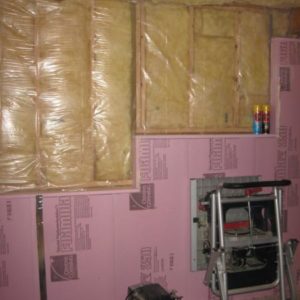
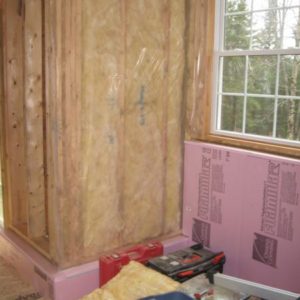
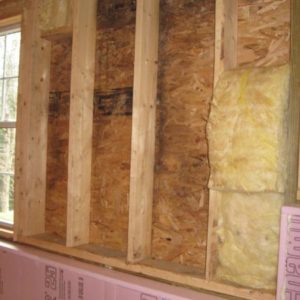

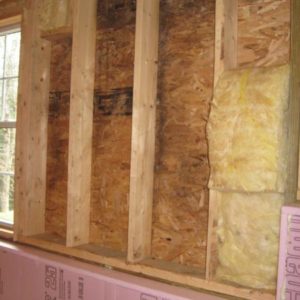
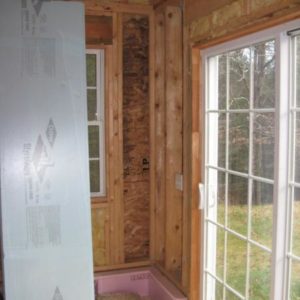
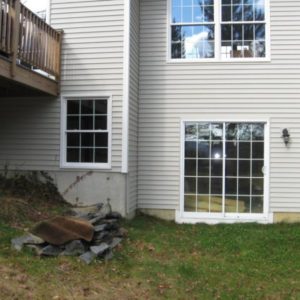



















Replies
My guess is that you're getting condensation on the inside of the sheathing in cold weather due to the fact that you have no vapor barrier installed.
Mike Hennessy
Pittsburgh, PA
Wouldn't it be more likely that condensation would show up at the bottom of the stud bays?
Not really -- depends on where the air is moister (warm, moist air rises), or the wall is colder, or where the most air infiltration is occuring.
Mike HennessyPittsburgh, PA
I had a poly VB installed throughout.
At least for the basement, to address any possibility of the poly simply locking moisture into the wall, replace the poly with Certainteed's "MemBrain" so-called "smart vapor retarder." It has a low perm when conditions are dry, but as RH of air next to it increases the permeability goes way up. That will let the cavity dry to the interior as required, yet prevent indoor humidity from diffusing too rapidly out into the cavity. Just don't let the air in the house get too humid.
Sounds too good to be true?
Any other takers on using- Certainteed's "MemBrain" so-called "smart vapor retarder" as a VR in a basement?
I just thought I'd add some notes on the MemBrain. On request, they will send you a little test kit. I got one last year some time. In it are two bags, one MemBrain and the other polyethylene. You soak the two thin wood sheets they provide in water for a few minutes, then seal each up in the bags.Over a couple of days you first see the moisture condensing on the inside of the two bags, but after a day the MemBrain bag isn't showing this as much. After perhaps 4-5 days you don't see the moisture in the MemBrain bag at all, and the thin wood sheet has dried out. Inside the poly bag nothing has changed; the wood is still soaking wet.As for the stuff being low-perm when the RH is low, I guess you'd have to measure that some other way, or just take their word for it. The web site does give a graph showing perm vs RH.The stuff is 4-mil nylon film, IIRC. I wondered about that, being thinner than 6-mil poly. It is tough, though, and won't tear easily. I even nipped the edge of the test sheet with scissors and tried to tear at the cut - no go.Expensive stuff, compared to poly, but as they say, a lot cheaper than a fix to a moisture/rot problem later. It does go along with the advice on buildingscience.com to avoid the use of poly and vinyl wallpaper in all but the coldest climates.I, too, would like to hear the opinions of others, since I am planning on using the stuff next year.
I too would be interested in real-world feedback on the Membrain product.I need to decide soon on what method of vapor retarder to use on my new construction home in a rather cold (6500HDD) climate. Cathedral ceilings and 2x6 standard construction. Lindal specs unfaced batts and poly VB however by contractor friend who is helping with my build has had trouble with the poly VB in a milder climate in the state.I am leaning towards a kraft-faced batt system rather than any poly or fancy membrane just so I don't build-in a potential hazard.Sorry for the hijack...
I've hada lot of Mem Brane or a similar product with BIBBs blown FG insulation systems in cathedral ceilings and walls on several houses over the past ten years and not problems showing up from it.i'd have far les confidence with FG batts ona Cathedral ceiling though. That is the utmost challenge for any insulation/ventilation system, and batts just don't measure up. I can't begin to count the number of times when i've had to diagnose false roof leaks shortly after a cold snap ( minus twenty or so for a few days) had caused excessive condensation and the following thaw that produces the drips with cathedral ceilings.
Welcome to the Taunton University of Knowledge FHB Campus at Breaktime. where ... Excellence is its own reward!
Here's my take.The vast majority of water intrusion stems from air infiltration, not vapor diffusion. The movement of air through a wall assembly can carry a significant amount of moisture.I sat through a lecture by a guy named Sam Rashkin who heads up the Energy Star for new homes program for the DOE. He said that, through an average heating season, a 4'x8' sheet of drywall will allow 1/3 cup of water to diffuse. But, if you cut a 1"x1" hole directly in the middle of the sheet of drywall, the amount of moisture that can pass through is now 33 cups. This is just an anecdote, but you can extrapolate that air infiltration is ~45,000 times worse. Like I said, don't take that figure to the bank, but even if it's off by a factor of 100, it's still significant.So, with that in mind, I think stopping air infiltration in your stud bays is the #1 concern. I would get some caulk or spray foam and first seal any holes and penetrations (hose bibs, electrical boxes, etc.).Second, I would caulk between the double top plates and between the PT sill plate and bottom plate of the wall.Lastly, I would direct your attention to the perimeter of the stud bays. You can seal the stud to the sheathing and the plates to the sheathing. As you get down the list, your returns will diminish so pay attention to the big stuff first.Cleaning your mold with a bleach solution will be sufficient. If you really wanted belt & suspenders, get some bor-a-care and spray/brush the stud bays. Maybe sprinkle some borax powder in the bottom of the stud bays before the insulation and drywall is installed.Your vapor barrier may be required by code, but I would check the BuildingScience.com website to see if they recommend a poly VB in your climate.
Jon Blakemore RappahannockINC.com Fredericksburg, VA
excellent point you make, but looking at the pattern of staining in the stud bays, it looks to me that his infiltration problem is moist air getting from the room past the plastic VB into the stid bay, because the VB has been poorly sealed by the pest guy taking down and putting back up several times. A VB is good when it is perfect, but once it is less than perfect, it is more likely to trap water, as pointed out by ( Josh - I think - a few posts back) so the situation calls for the air barrier Mem Brane instead of the VB, along with finishing things off better.I would add tho, that I have worked on several places with DIYs in various similar situations, and I think that if there had been no VB in place, the problem here could have been worse. Also, good on this owner for keeping an eye on it pro-actively and doing something to get ahead of it. A lot of my income lately has been fixing things where they turned a blind eye to this sort of thing until rebuilding was required
Welcome to the Taunton University of Knowledge FHB Campus at Breaktime. where ... Excellence is its own reward!
I agree with your comments.In our climate (albeit, different from MA), I like to stay away from membranes or vapor barriers and just eliminate infiltration.I forgot to mention that, when the sheetrock is installed, the OP should take care to detail any penetrations so, hopefully, all infiltration (and the resulting water volume) will be eliminated.
Jon Blakemore RappahannockINC.com Fredericksburg, VA
Good call on that. This is an excellent place for the Membrane
Welcome to the Taunton University of Knowledge FHB Campus at Breaktime. where ... Excellence is its own reward!
Maybe is the presence of carpenter ants in the wall an indication of something else going on before pest control even got there?
i.e. they like to burrow in decayed wood.
Edited 11/19/2008 2:07 pm ET by Ten_Thumbs
In my experience, carp ants is an indication of moisture problems. They will not move more than about 18" from moisture. The wood is already damp or they would not want to be there.The pattern of the stains suggests to me that when the spray guy keeps pulling the VB and FG, then putting it back, he is allowing a loose concvection channel in the stud bay. FG is not great for stoipping convection anyways unless fitted perfectly, and same with VB - if you take it down and put it back, there are holes torn in it from the staples allowing moisture in.You will also have more condensation in the upper space in a situation like yours.
Welcome to the Taunton University of Knowledge FHB Campus at Breaktime. where ... Excellence is its own reward!
You may have a grade issue with the soil surrounding your home. It is hard to tell with that one outdoor photo. The good news: vinyl is easy to remove so replacing the sheathing and or studs will be a cinch!
What do the moldy areas feel like? It looks to me like just a minor case of mold, I cannot see any serious damage.
My guess is the moisture from the pest treatment stayed around long enough to cause some mold to form.
Open the insulation below the window sills. Do those bays look the same?
Jon Blakemore
RappahannockINC.com Fredericksburg, VA
I agree, a quick scrub with 10% bleach, dry it, and put it all back right. There is no serious issue here IMO
Welcome to the Taunton University of Knowledge FHB Campus at Breaktime. where ... Excellence is its own reward!
Just catching up with this discussion.
The mold (what there is of it) is limited to the tops of the bays. Also, it appears to be only in bays that were treated by the pest guy- although I can't be absolutly certain.
I took great pains to make sure the grade was set so I would not have any water issues-the basement is dry as a bone-except for some incrediable condensation in the summer months on water pipes/well storage tank.
So the consensus is-
Treat the existing mold with 10% bleach, let her dry out, replace the fiberglass and replace the poly VB making sure there are no gaps for leakage?
Thanks
Skippy
I agree, a quick scrub with 10% bleach, dry it, and put it all back right. There is no serious issue here IMO
Somewhere online (one of the building science type legit websites) that bleach doesn't really "kill" the mold. It does tend to bleach the color out of it, but viable spores remain. It was recommended to use some other solution that actually kills the mold spores. A fungicide will kill the mold spores.
Some fungicides that are recommended are boric acid and hydrogen peroxide. Even white vinegar, altho the strong "salad dressing" odor is a deterent to use it.
I've had light-green fuzzy mold grow on my wood sash windows (newer Anderson DH 400 series vinyl/wood sash) where some moisture condensation occurs during Winter. I've bleached it to the point that the stain/sealer is removed and the wood fibers got raised almost like suede (which I sanded down and re-stained-sealed). But the mold fuzz returned very quickly.
I have even used Boraxo, making a paste that I let dry on the wood then vacuumed up. This lasted almost a year, but the fuzz returned. Recently I tried a sodium carbonate solution. Jury is still out. I did read that it is more of a mold PREVENTER than a killer.
My house doesn't "seem" excessively humid. I have a humidity gauge altho I know it is NOT a "scientific" instrument, it reads 40% or so in Winter. No idea if it is accurate or even close. I get maybe 1/2" band of droplets/"sweat" at the bottom of each sash glass; the fuzz happens on the wood bottom sash portion just where it meets the glass. On strong sunny days the droplets evaporate on their own.
Next I might try Tea Tree Oil - I hope it is not very smelly.
Quantum materiae materietur marmota monax si marmota monax materiam possit materiari?
It is true that there are other better products.But I was trying to communicate easy and fast for a DIY HO without getting into that one. Once the surface growth is stopped, spores do remain, but they exist in all of life as well. As long as things are kept dry, those spores do not grow. thus my added comment to let it dry well first before covering back up tight.
Welcome to the Taunton University of Knowledge FHB Campus at Breaktime. where ... Excellence is its own reward!
Not all the bays have a mold issue-seems to be in the corners where I'm guessing the pest guy hit with spray. Also, it's only at the top of the bay, if it was a VB issue I would have thought it'd be throughout the bay.
Skippy
I think the mold is from the pest guy, and I think the vapor barrier is excessive. I don't claim to understand it all, but I would suggest you go to http://www.buildingscienceconsulting.com/index.html , it has a wealth of information about this topic, just look around.
Based on what I've read and the pictures, those portions of your basement wall that are above grade are covered with the vapor barrier, which (depending upon how well sealed it is) traps in all the water vapor in the basement. Not conditioning this space ensures the water vapor is locked in even more. During the winter, the basement wants to dry to the outside, which the vapor barrier blocks, but since it is colder down there it doesn't carry as much water vapor as the conditioned areas, so you're probably ok, it will dry up to the conditioned areas. I would not go so far as to remove the vapor barrier completely. When the insde of the house is warmer than the outside you do not want that warm moist interior air hitting the outside wall, it will condense and cause mold. You need something to mitigate the movement of water vapor, kraft faced fiberglass is a vapor retarder which would do this.
In the summer, with the outside warmer than the inside (I'm assuming since you said it's not conditioned), the basement naturally wants to dry towards the interior. Since it's not conditioned you do not get the natural dehumidification from air conditioning, and you probably have some water vapor movement from the upper floors to the basement(possibly) which would explain the condensation on the pipes. To alleviate your condensating pipes, I'd add some type of dehumidification for this, or condition the area.
You probably will be ok to treat the mold and replace the vapor barrier, but I'm not sure I would call it ideal.
Just my opinion though, I'm nothing close to an expert.
Edited 11/20/2008 9:35 am ET by JoshRountree
Edited 11/20/2008 9:36 am ET by JoshRountree
Edited 11/20/2008 9:36 am ET by JoshRountree
Edited 11/20/2008 9:37 am ET by JoshRountree
Just trying to understand to satisfy my own curiosity. Were there carpenter ants in the stud bays before pest control sprayed, or was that just a preventative measure? If it was just preventative, I agree with Piffin.
Edited 11/20/2008 10:29 am ET by Ten_Thumbs
There were signs of carpenter ants-that's why I called him in. I think a lot of the spraying became preventative once he got going. The house is two years old-there are no signs of any wet areas where they would be inclined to gather. The back fill was all clean stuff, the grading is ok and I've directed the gutters 20+ feet away from the house.
Skippy
Why did you spray for carpenter ants? Was there a problem, or was it a prophylactic measure?
Jon Blakemore
RappahannockINC.com Fredericksburg, VA